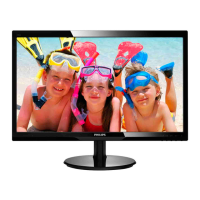
Do you have a question about the Philips 246V5LAB and is the answer not in the manual?
| 3D | No |
|---|---|
| Panel type | TFT |
| Pixel pitch | 0.277 x 0.277 mm |
| Aspect ratio | 16:9 |
| Display diagonal | 24 \ |
| Display technology | LCD |
| Vertical scan range | 56 - 75 Hz |
| Horizontal scan range | 30 - 83 kHz |
| Viewable size, vertical | 298.89 mm |
| Viewing angle, vertical | 160 ° |
| Contrast ratio (typical) | 1000:1 |
| Display number of colors | 16.78 million colors |
| Viewable size, horizontal | 531.36 mm |
| Viewing angle, horizontal | 170 ° |
| Display brightness (typical) | 250 cd/m² |
| Supported graphics resolutions | 1920 x 1080 (HD 1080) |
| Storage temperature (T-T) | -20 - 60 °C |
| Operating temperature (T-T) | 0 - 40 °C |
| AC input voltage | 100 - 240 V |
| AC input frequency | 50 - 60 Hz |
| Power consumption (off) | 0.3 W |
| Power consumption (standby) | 0.5 W |
| Power consumption (typical) | 20.16 W |
| Mean time between failures (MTBF) | 30000 h |
| HDCP | Yes |
| HDMI ports quantity | 0 |
| RMS rated power | 4 W |
| Number of speakers | 2 |
| Tilt angle range | -5 - 20 ° |
| Height adjustment | - |
| Cable lock slot type | Kensington |
| Panel mounting interface | 100 x 100 mm |
| On Screen Display (OSD) languages | CHI (SIMPL), DEU, ESP, FRE, ITA, POR, RUS, TUR |
| Product color | Black |
| Package depth | 131 mm |
| Package width | 613 mm |
| Package height | 446 mm |
| Package weight | 6050 g |
| Sustainability certificates | EPEAT Silver, ENERGY STAR |
| Depth (with stand) | 238 mm |
|---|---|
| Height (with stand) | 435 mm |
| Weight (with stand) | 4650 g |
| Depth (without stand) | 63 mm |
| Width (without stand) | 565 mm |
| Height (without stand) | 354 mm |
| Weight (without stand) | 4220 g |
Essential safety guidelines and maintenance procedures for operating and caring for the monitor.
Steps for unpacking, identifying contents, and attaching the monitor's base stand.
Instructions for connecting the monitor to a computer using various input ports.
Overview of the monitor's front panel controls and basic operational functions.
Details on the On-Screen Display menu, resolution notifications, and physical adjustments like tilt.
Guides for adjusting key display parameters like brightness, contrast, focus, and position via software.
Instructions for adjusting color settings, black level, and white point using the software.
Steps for calibrating the display and managing resolution settings through the software.
Details on maximum and recommended display resolutions and supported preset modes.
Explanation of power consumption modes (Active, Sleep, Switch Off) and LED indicators.
Product conformity declarations for CE (Europe) and FCC (USA) regulations.
Philips' policy defining acceptable levels for pixel and sub-pixel defects on monitor panels.
Solutions for common monitor problems like no picture, smoke, or imaging issues.